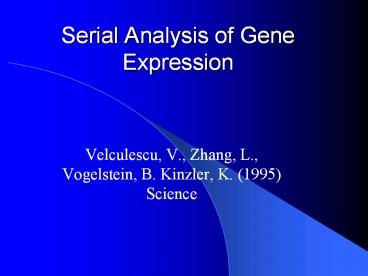Serial Analysis of Gene Expression - PowerPoint PPT Presentation
Title:
Serial Analysis of Gene Expression
Description:
Victor Velculescu: Dept. of Oncology, Johns Hopkins University. ... Ken Kinzler: Dept. of Oncology, Johns Hopkins University. Aim of This Paper ... – PowerPoint PPT presentation
Number of Views:828
Avg rating:3.0/5.0
Title: Serial Analysis of Gene Expression
1
Serial Analysis of Gene Expression
- Velculescu, V., Zhang, L., Vogelstein, B.
Kinzler, K. (1995) Science
2
Authors The Wild-Types
- Victor VelculescuKeyboard
- Ken KinzlerDrummer
- Bert VogelsteinKeyboard
- Lin ZhangHonorary member
3
Current Research
Victor Velculescu Dept. of Oncology, Johns
Hopkins University. -New therapeutic targets for
colon cancer Lin Zhang Dept. of Pharmacology,
University of Pittsburg. -genetic basis of
differential sensitivity to anticancer drugs, as
well as the genetic alterations in cancer cells
that cause drug resistance Bert Vogelstein Dept.
of Oncology, Johns Hopkins University. -Identifica
tion and characterization of oncogenes. Ken
Kinzler Dept. of Oncology, Johns Hopkins
University.
4
Aim of This Paper
- Provide researchers with a means to study
expression of an entire genome rather than single
genes - To create a method of comparing gene expression
differences between two samples with information
about abundance of transcripts - To illustrate effectiveness of this technique by
examining pancreatic gene expression patterns - To confirm the quantitative nature of the novel
technique through library screening
5
Major Findings
- Developed a new technique to study gene
expression that is capable of quantitative
analysis of an entire genome - Characterized gene expression in human pancreas
- Used SAGE to identify novel cDNA transcripts
6
SAGE Based on 2 principles
- A 9 bp tag is sufficient to unambiguously
identify a gene - Concatenation (linking together) of these short
DNA sequences increases the efficiency of
identifying unique transcripts in a serial
manner.
7
Methods
- mRNA cDNA
- Cleave with A.E
- Isolate 3 most transcript of each cDNA by
binding to Streptavidin beads - Divide cDNA in half
- Ligate to 1 of 2 linkers (each with a T.E site)
- Ligate the two pools of tags together.
FIG. 1 SAGE protocol
8
Methods
- Ligated linkers serve as primers for
amplification - Cleave PCR products with A.E. to isolate ditags
- Concatenate by ligation
- Clone
- Sequence
FIG. 1 SAGE protocol
9
SAGE Analysis Human Pancreas
Table 1. Pancreatic SAGE tags.
10
Comparison of Transcript Abundance
- Quantitative nature of SAGE tested by
construction of a pancreatic cDNA library that
was screened with cDNA probes for several
pancreatic genes - Relative abundance of SAGE tags agreed with
results from library screening
11
Current Applications
- Gene Discovery
- Analysis of Cardiovascular gene expression
- Gene expression in carcinogenesis
- Substance abuse studies
- Cell, tissue and developmental stage profiles in
C. elegans - Profiling of human diseases
- and more..
12
Other Technologies to Study Expression
- Expressed Sequence Tags (ESTs)
- RT-PCR
- RNA Blotting
- DNA Microarrays
13
Expressed Sequence Tags
- Short, annotated sequences at 3 or 5 end
- Can be used to determine the number of
genes/genome - Can be used to identify novel genes
14
qRT-PCR
- Can be used to both detect quantify gene
expression - Not high-throughput
- Can only be used on a limited scale
15
RNA Blotting
- To quantify RNA (semi-quantitative)
- Can detect RNA slicing
- Again, not quantitative
16
DNA microarrays
- High-throughput
- Allows for simultaneous detection of genome-wide
expression - Can provide relative quantitative information
about expression
17
Microarray vs. SAGE
18
C. elegans temporal Tissue-Specific Expression
Profiling Project
- About 1.9 million C.elegans tags sequenced to
date - Several libraries have been completed, including
Embryo, all larval stages, Young and old adult,
sterile adult, microdissected gut tissue,
FACS-sorted muscle cells, and FACS embryonic
intestinal cells - Several libraries are in progress, including
FACS-sorted pan-neural cells, FACS-sorted
ciliated neurons, FACS pharynx, and FACS
hypodermal cells
19
Long SAGE vs. Short SAGE
- A comparison of short SAGE (14bp) vs. long SAGE
(21bp) - Some tags are not unambiguously assigned to a
gene (similar 3 ends due to ancestral
duplications) - About 12 of C. elegans tags are not
unambiguously identified using 14bp tags - Results of empirical data suggests that LongSAGE
gives far greater resolution, but at an increased
cost.
20
Why is this paper a landmark?
- New technique for quantitative analysis of gene
expression - Identified novel transcripts in pancreatic
samples - Has allowed for the characterization of gene
expression, both temporally and spatially, in
several organisms - Currently is being used to study disease (i.e.
cancer) gene expression
sciencepark.mdanderson.org/ ggeg/SAGE_technique.h
tm
21
References
- Velculescu, V., Zhang, L., Vogelstein, B.
Kinzler, K. (1995). Serial Analysis of Gene
Expression Science 270 (5235) - Reinke, V. (2002). Functional Expolation of the
C. elegans Genome Using DNA Microarrays. Nature
Genetics 32
22
(No Transcript)
















![Gene Expression [M.Tevfik DORAK] PowerPoint PPT Presentation](https://s3.amazonaws.com/images.powershow.com/P1254325768SmTMy.th0.jpg?_=20140215056)














